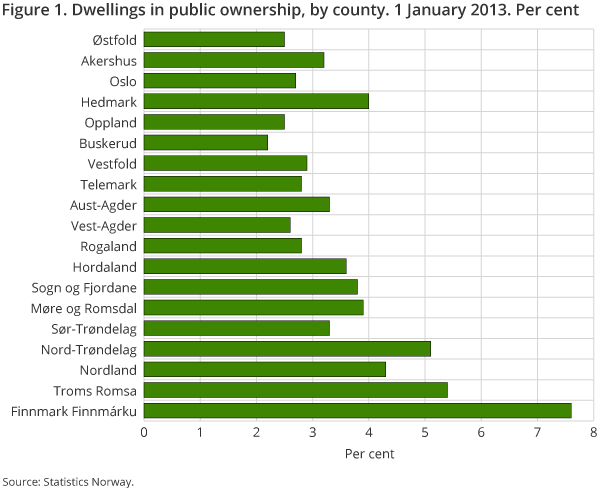Content
Published:
This is an archived release.
Few dwellings owned by public bodies
Just 3 per cent of the dwelling stock is owned by public bodies, most of which are owned by municipalities. More than 7 out of ten dwellings are owned by private persons. A good 90 per cent is privately owned when including ownership by private companies and housing cooperatives.
| 2012 | 2013 | Change | |
|---|---|---|---|
| 2012 - 2013 | |||
| 1Changes last period are net changes. Some changes may be due to variable lag in registering of new dwellings. | |||
| Total | 2 422 048 | 2 449 210 | 27 162 |
| Detached house | 1 275 190 | 1 278 960 | 3 770 |
| House with 2 dwellings | 222 159 | 223 783 | 1 624 |
| Row house, linked house and house with 3 dwellings or more | 275 805 | 281 360 | 5 555 |
| Multi-dwelling building | 536 995 | 550 366 | 13 371 |
| Residence for communities | 44 480 | 45 579 | 1 099 |
| Other building | 67 419 | 69 162 | 1 743 |
Even though relatively few dwellings are in public ownership 1 , there are large regional variations. This is particularly evident when comparing the smallest municipalities. In Svalbard, almost 54 per cent of the dwellings are owned by public bodies, due to the mining activities.
There were a total of 2 49 210 dwellings in Norway as at 1 January 2013, of which more than half (1 278 960) were detached houses. Flats in multi-dwelling buildings followed with 550 366, while there were 281 360 dwellings in row houses, linked houses and houses with three or four dwellings. There were 223 783 dwellings in houses with two dwellings and 45 579 dwellings in residences for communities. The remaining 69 162 dwellings are registered in buildings where the main part of the floor space is used for purposes other than dwellings; mainly industrial buildings.
More multiple dwellings
In recent years there has been a major increase in the number of apartment blocks. The number of flats has increased by more than 70 000 since 2006, and now counts for a good 22 per cent of the dwellings.
Compared with the other Nordic countries, Norway still has a relatively low share of dwellings in “other than one- and two-family houses”. In Norway, this makes up 34 per cent of the dwellings, while the figures for Denmark, Finland and Sweden are 38, 44 and 56 per cent respectively.
Adjusted dwelling population
The dwelling population as of 1 January 2012 was adjusted with 49 335 extra dwellings, mainly dwellings in one- and two-family houses. The corresponding figures for 1 January 2013 were adjusted with 44 422 extra dwellings. This is based on information from household statistics, which indicate that some dwellings are not yet registered in the dwelling register.
Enhanced quality
The quality of the dwelling statistics is gradually improving each year. Most of the dwellings in buildings with little information are gradually replaced with new buildings, or new information is available when dwellings are for sale. In addition, the increase in the number of registers used in the production of the statistics also affects the quality.
1 Owned by municipality, counties or state.
Improvement of the GAB register/MatrikkelenOpen and readClose
The municipalities are cleaning up their registers to improve the quality. This is being done continually and also especially in connection with the transition to the new official building register, “Matrikkelen”. Dwellings that were incorrectly classified the previous year may have been assigned the correct information the following year. The number of registered dwellings in the municipalities may also change from year to year because of the clean up. As a result, the number of dwellings in some of the municipalities may not be directly comparable with the previous year.
Extension of the statisticsOpen and readClose
In autumn 2013, the plan is to also publish figures for construction year, utility floor space, number of baths, WCs and kitchen facilities for dwellings as at 1 January 2012 and 2013. The goal is also to have statistics on number of residents per dwelling, density (floor space per resident) and ownership (owned and rented dwellings).
Contact
-
Jens Mathiesen
E-mail: jens.mathiesen@ssb.no
tel.: (+47) 40 81 13 98
-
Mona Takle
E-mail: mona.takle@ssb.no
tel.: (+47) 40 81 14 12

